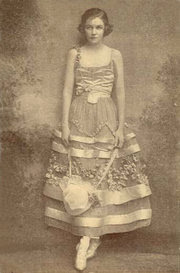 By Vicki Gaia
By Vicki GaiaWhen researching fashion trends from my 1910 novel, Eliza's Hope, I discovered how much art influenced fashion. Art and fashion were closely linked in the past, more than today. The artist didn't think anything of designing textile patterns, theater sets, dinner ware, along side of original works of art.
 Paris fashion designers relied on their artists. The famed French couturier, Paul Poiret, moved in artistic circles and employed artists. "I have always liked painters." Friends with the Fauvist painter, Francis Picabia, they'd shared a love of bright colors. Poiret collected Picasso, Dufy, Matisse and other modern artists of his time. He also loved the theater, and when the Ballet Russes (Russian ballet company) first appeared in Paris in 1909, their costumes set off the Oriental craze. Poiret designed flowing pantaloons, turbans, kimonos, all in bold vivid colors, never seen before.
Paris fashion designers relied on their artists. The famed French couturier, Paul Poiret, moved in artistic circles and employed artists. "I have always liked painters." Friends with the Fauvist painter, Francis Picabia, they'd shared a love of bright colors. Poiret collected Picasso, Dufy, Matisse and other modern artists of his time. He also loved the theater, and when the Ballet Russes (Russian ballet company) first appeared in Paris in 1909, their costumes set off the Oriental craze. Poiret designed flowing pantaloons, turbans, kimonos, all in bold vivid colors, never seen before. The American dance idols, Vernon and Irene Castle, influenced early 20th century fashion. Hemlines went up, and ankles were exposed to accommodate the new Fox Trots and ragtime dances. Satin slippers with sexy ankle straps accessorized the outfit.
The American dance idols, Vernon and Irene Castle, influenced early 20th century fashion. Hemlines went up, and ankles were exposed to accommodate the new Fox Trots and ragtime dances. Satin slippers with sexy ankle straps accessorized the outfit.These energetic dances were best performed in fitting dresses with long side slits that allowed for dramatic movements. This type of dancing required a new closeness and a certain intimacy between partners, so it was inevitably frowned upon by less liberal people still locked in Victorian mores and customs. ~ Fashion Era
 I can't leave out the Art Deco movement--which started in 1900 and peaked in the 1920's. During the early Art Deco period, skirts became tubular and straight, relaxed and with a semi-fitted silhouette, reminiscent of the Empire period. This silhouette no longer required the stiff corsets, hemlines went up, as well as the waist, which rose higher and eventually disappeared.
I can't leave out the Art Deco movement--which started in 1900 and peaked in the 1920's. During the early Art Deco period, skirts became tubular and straight, relaxed and with a semi-fitted silhouette, reminiscent of the Empire period. This silhouette no longer required the stiff corsets, hemlines went up, as well as the waist, which rose higher and eventually disappeared.From the Beginner's Guide to Art Deco:
What is Art Deco design? French romance, fruit filled cornucopias, images of still fountains, Oriental rugs. Coco Chanel, Egyptian tapestries, Jazz inspired pottery, lightning bolts and Zig Zags! Modernized chrome and steel home appliances, running Gazelles, pink flamingos and straight, clean lined furniture. Enameled vases, wrought iron tables, copper kitchenware, Lalique glass, and chrome ashtrays. Colorful, sexy, sleek and modern! That is Art Deco in a nutshell.Happy Reading!
Vicki